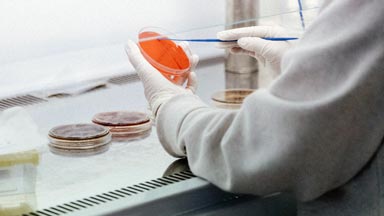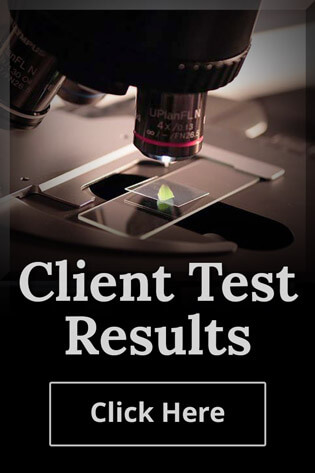Preservative Efficacy Testing | USP <51>

Preservative Efficacy Testing USP <51> is a testing protocol used to determine the efficacy of the preservative system in products with aqueous vehicles and/or bases that are defined as products with a water activity of ≥0.6.
Frequently referred to as Preservative Efficacy Testing (PET), Antimicrobial Effectiveness Testing (AET), or Preservative Challenge Testing, USP <51> testing is available at our laboratory.
Have questions or want to request a quote for Preservative Efficacy Testing USP <51>? Contact Jeremy at Jeremy@aatestlabs.com. You can also call us at (616) 837-7670 for more information.
Preservative Efficacy Testing USP <51> Protocol
Product is tested initially for the presence of Bacteria, yeast, and mold to confirm sterility. If organisms are present in the sample, we will determine if they interfere with the Preservative Efficacy Testing USP <51> protocol.
Immediately following the results from the initial sterility testing, the product is inoculated with specific strains of bacteria, yeast, and mold recommended by USP.
- Staphylococcus aureus - Bacteria
- Escherichia coli - Bacteria
- Pseudomonas aeruginosa - Bacteria
- Candida Albicans - Yeast
- Aspergillus brasiliensis - Mold
Protocol requires introduction of a known level of USP listed organisms into the product to challenge the preservative system and quantified at designated intervals of 0, 1, 7, 14, and 28 days.
Product Classification & Preservative Efficacy Testing USP <51> Results Criteria
Results are based on the classification of the products and criteria specified by USP and referenced in the tables below.Table 1. Compendial Product Categories
| Category | Product Description |
| 1 | Injections; other parenterals including emulsions, otic products, sterile nasal products, and ophthalmic products made with aqueous bases or vehicles. |
| 2 | Topically used products made with aqueous bases or vehicles; nonsterile nasal products and emulsions, including those applied to mucous membranes. |
| 3 | Oral products other than antacids, made with aqueous bases or vehicles. |
| 4 | Antacids made with an aqueous base. |
Table 2. Criteria for Tested Microorganisms
For Category 1 Products
| Bacteria | NLT 1.0 log reduction from the initial calculated count at 7 days, NLT 3.0 log reduction from the initial count at 14 days, and no increase from the 14 days' count at 28 days. |
| Yeast & Molds | No increase from the initial calculated count at 7, 14, and 28 days. |
For Category 2 Products
| Bacteria | NLT 2.0 log reduction from the initial count at 14 days, and no increase from the 14 days' count at 28 day. |
| Yeast & Molds | No increase from the initial calculated count at 14 and 28 days. |
For Category 3 Products
| Bacteria | NLT 1.0 log reduction from the initial count at 14 days, and no increase from the 14 days' count at 28 days. |
| Yeast & Molds | No increase from the initial calculated count at 14 and 28 days. |
For Category 4 Products
| Bacteria, Yeast, and Molds | No increase from the initial calculated count at 14 and 28 days. |
Preservative Efficacy Testing USP <51> Timeline
- Initial sterility testing 5-7 days
- Preservative Efficacy Testing Begins
- Day 0- Inoculation
- Day 1- Organisms are quantitated to confirm appropriate inoculation level of greater than 5-6 Log10 (100,000 – 1,000,000 cfu)
- Day 7 – Test samples are quantitated to determine rate of reduction
- Day 14 – Test samples are quantitated to determine rate of reduction
- Day 28 – Final testing date and samples are quantitated to determine rate of reduction
In total this testing protocol takes approximately 45-50 days from start to finish with a final report.
Preservative Efficacy Testing USP <51> Sample Requirements
- Completed sample request form (CLICK HERE)
- Including description of your product (Cream, Topical Lotion, Serum, etc.)
- 230 mL or 230 grams of sample
- Bulk packaging is acceptable, however final product packaging is preferred.
- Multiple small containers can be submitted.
Frequently Asked Questions
Can Alliance Analytical Laboratories help interpret the results?
YES! Once your final report is issued, please contact Jeremy at (616) 837-7670 or jeremy@aatestlabs.com and he will assist with interpreting your results.
How long does the testing take?
The Preservative Efficacy Testing USP <51> protocol takes a duration of 42 days from start to final results.
Do I receive updates throughout the study?
YES! Using our client portal (HERE) you have access to real-time data so you can see how the product is progressing throughout the testing protocol.
How will I know if the product has passed or failed?
Upon conclusion of the Preservative Efficacy Testing USP <51> protocol the final report has a clear determination of pass or fail based on the criteria below.
If my product fails does Alliance Analytical Laboratories offer consulting services for formulation adjustments?
YES, to a certain extent. Your product can be discussed with our Technical Director to determine if other preservatives or preservative systems are applicable.
How much sample do I need to send?
We request 230 mL or 230 grams of sample.
Contact our Preservative Efficacy testing USP <51> laboratory today at (616) 837-7670 if you would like to speak directly with our team. Message us here to reach out via our website or email Jeremy at jeremy@aatestlabs.com.

 Microbiology
Microbiology